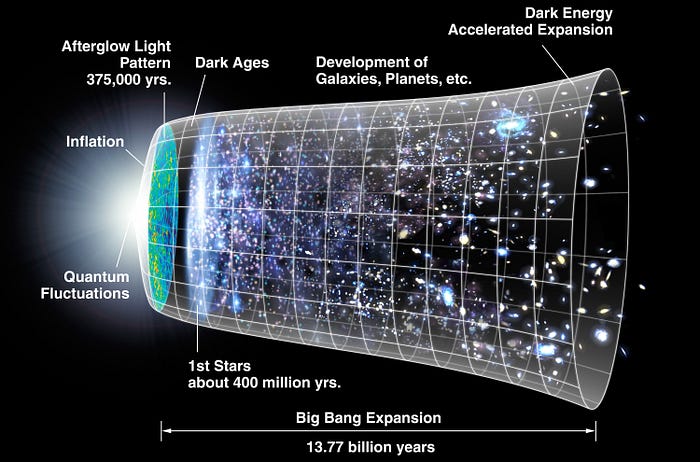
The Sun is a common star at present and its lifetime is comparable to the age of the Universe. This is not a coincidence. If the Sun had died by now, the Earth would have not been habitable and we would not be observing the cosmos through terrestrial telescopes.
But shorter-lived stars could have matched the age of the Universe earlier in cosmic history. These stars were more massive than the Sun. The earliest stars observed by the Webb telescope potentially out to redshifts 15–20 were at least twenty times younger than the Sun, since the Universe was only two hundred million years old then.
Going even further back in time, the first stars formed about forty million years after the Big Bang and were likely much more massive than present-day stars. The early gas clouds lacked the heavy elements which constitute the main coolants of present-day stellar nurseries. Primordial gas clouds made of hydrogen and helium remained warm and fragmented into massive clumps that seeded the first stars. Being tens of times more massive than the Sun, these early stars had lived for only a few million years and are not around anymore.
It is possible to use the oldest stars at any given epoch to time-stamp the age of the Universe as a function of cosmic scale factor, a=1/(1+z), where z is the cosmological redshift. Following this rationale, I wrote a new paper with Sunny Vagnozzi and Fabio Pacucci, in which we suggested using the oldest objects as a function of redshift to time-stamp the cosmic expansion history. The cosmic scale factor measures the amount by which a wavelength of light is stretched as the Universe expands.
The universe resembles a spherical archaeological dig centered on us. The deeper we look into space, the more ancient is the layer that we uncover. Owing to the finite speed of light, we see old images of distant sources that display the way they looked like light-travel-time ago. If we allow time to elapse, we would see the same sources at a later age. We usually consider redshifts as labels of distant objects in a snapshot of the universe’s expansion. But in fact, they are frames of a very slow-motion film, and we could in principle watch this film roll by waiting long enough.
In a second new paper that I published with Bob Scherrer, we considered the possibility that cosmologists will follow the cosmic expansion history in real time. Our existing cosmological data was collected over the past century. Now, suppose that this data collection process will continue for ten thousand years. What are the new insights that will be gained about the Universe?
First, one could aim to observe the evolving expansion of the Universe in real time by monitoring the slight changes in the cosmological redshift of intergalactic gas clouds, a possibility that I proposed in a 1998 paper following on earlier work by Alan Sandage which considered this measurement impractical for galaxies. Detecting this so-called Sandage-Loeb Test, is potentially feasible with planned high-resolution spectrographs on the next generation of extremely large, ground-based telescopes.
During the first half of the history of the universe — the cosmic expansion rate slowed down owing to the attractive gravity imparted by radiation and matter, but during the second half — radiation and matter were diluted so much that the vacuum’s “dark energy” dominated and the cosmic expansion was accelerated by the vacuum’s repulsive force. By monitoring the slow cosmic expansion in real time, we can observe the early deceleration at high redshifts and the late acceleration at low redshifts. The transition between the two phases would pin-down the cosmic mass budget in terms of the relative proportions of dark matter — which dominates early on, and dark energy — which dominates at late times. All in all, the redshift drift associated with the aforementioned Sandage-Loeb Test provides us with a direct view of how the universe expands as if we are watching the sky like a screen in a movie theatre. Cosmic evolution is also potentially detectable as slow changes in the brightness fluctuations of the cosmic microwave background; most notably in its quadrupole moment — owing to the Sun’s acceleration around the Milky-Way center — as I pointed out in a recent paper.
In addition, the location of cosmological sources on the sky would change as a result of the motion of the Sun relative to the cosmic frame of reference. Over ten thousand years, the resulting parallax would change the sky position of our sister galaxy, Andromeda, by an arcsecond, nearly measurable by amateur astronomer telescopes.
Long-term observations will also allow us to detect rare events, such as a massive star collapsing to a black hole, or hundreds of neutrino bursts from supernovae over ten thousand years in the Milky-Way galaxy alone.
Finally, cosmologists would be able to constrain much better the possible time-evolution of fundamental constants, such as Newton’s constant or the fine-structure constant.
Our descendants ten thousand years from now will likely be sentient computer systems with Artificial Intelligence (AI). These AI-scientists could live much longer than our lifespan, so ten millennia could appear short to them. This will be the case as long as unplugging them from the electric outlet will be banned by law similarly to the murder of humans. Here’s hoping that future AI-cosmologists will appreciate the baby steps we made during the past century in understanding the Universe. Perhaps they would cite the paper I wrote with Bob, just to illustrate the point that our generation of cosmologists did not know the nature of dark matter and dark energy. They would find it surprising that we got paid even though we had no idea of what most of the Universe is made of.
ABOUT THE AUTHOR

Avi Loeb is the head of the Galileo Project, founding director of Harvard University’s — Black Hole Initiative, director of the Institute for Theory and Computation at the Harvard-Smithsonian Center for Astrophysics, and the former chair of the astronomy department at Harvard University (2011–2020). He chairs the advisory board for the Breakthrough Starshot project, and is a former member of the President’s Council of Advisors on Science and Technology and a former chair of the Board on Physics and Astronomy of the National Academies. He is the bestselling author of “Extraterrestrial: The First Sign of Intelligent Life Beyond Earth” and a co-author of the textbook “Life in the Cosmos”, both published in 2021.
